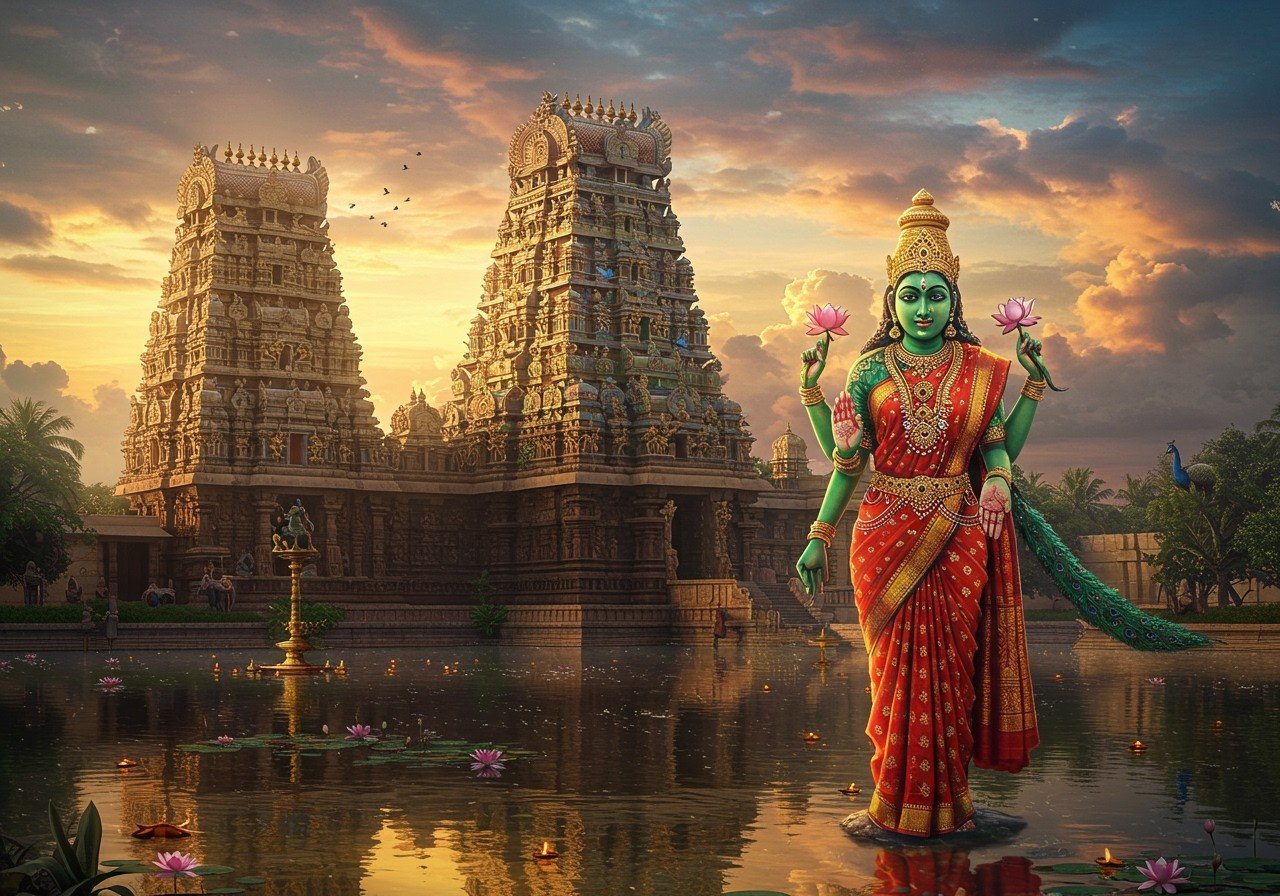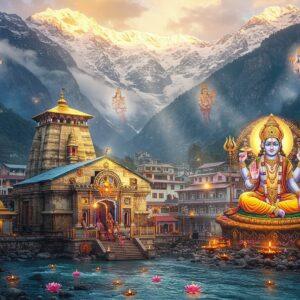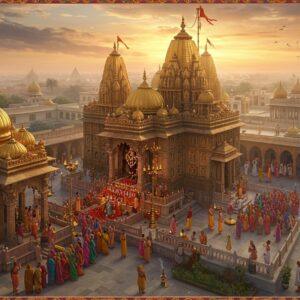
The Meenakshi Amman Temple in Madurai, Tamil Nadu, is a true marvel of architecture and a testament to deep devotion. Situated on the southern bank of the Vaigai River, this temple stands as a proud symbol of India’s rich cultural tapestry. It’s more than just bricks and mortar; it’s a living, breathing embodiment of Tamil heritage, profound devotion, and artistic brilliance.
Its roots trace back to the 6th century CE, and its grandeur expanded significantly during the Nayak dynasty in the 16th and 17th centuries. The towering gopurams (gateway towers), adorned with vibrant and intricate sculptures, narrate captivating tales of deities and ancient myths. Every year, millions of devotees and tourists alike journey to this sacred site to witness its splendor and immerse themselves in its spiritual offerings.
Spiritual Essence of Meenakshi Amman Temple
At the very heart of this temple resides the divine couple: Goddess Meenakshi and Lord Sundareswarar. Meenakshi, a form of Goddess Parvati, embodies boundless compassion and profound wisdom. Her consort, Sundareswarar, represents the beautiful Lord Shiva. Their divine union is celebrated here, symbolizing eternal love and the inherent unity of the cosmos. This sacred union reminds us of the beautiful balance between feminine and masculine energies within the universe.
The temple’s location in Madurai connects it deeply to the historical Tamil Sangam period, further enriching its cultural significance. As a revered center for both Shaivism and Shaktism, it offers spiritual solace and a profound connection to the divine through its various rituals and ceremonies. Darshan, the act of viewing the deity, plays a crucial role in uplifting the spirits of devotees and fostering a sense of closeness with the divine.
Explore other divine destinations in India.
Celebrated Deities within the Temple
Within the temple’s sanctum sanctorum, you’ll find the mesmerizing emerald-hued idol of Meenakshi, her fish-shaped eyes a unique symbol of her ever-watchful compassion and omniscience. Beside her stands Sundareswarar, her divine counterpart. The temple also houses other revered deities, including Vinayaka (Ganesha), Murugan, and the Navagrahas (nine planetary gods). Each deity plays a significant role in the rich tapestry of Hindu belief and influences the lives of devotees in unique and meaningful ways.
Daily worship at the Meenakshi Amman Temple is a vibrant and deeply moving experience. Abhishekam, the sacred ritual of anointing the idols with holy substances, and aarti, the offering of light, create an atmosphere permeated with devotion and reverence. These daily rituals connect us with the divine and bring a sense of peace and blessings to our lives.
You can enhance your personal puja at home with authentic items from Poojn.in. We offer pure copper items and murtis of various deities, crafted with utmost care and reverence.
Festivities at Meenakshi Temple
The festivals celebrated at the Meenakshi Amman Temple are truly a sight to behold. The Meenakshi Thirukalyanam, a grand celebration of the celestial wedding of Meenakshi and Sundareswarar, is the most magnificent of all. This vibrant event takes place during the Chithirai month (April-May) and draws thousands of devotees from far and wide to witness this sacred union. The air is filled with joy, devotion, and a sense of shared celebration.
Other key festivals include Navaratri, a time to honor the goddess’s myriad forms, and Shivaratri, a celebration of Lord Shiva’s cosmic dance. These festivals are marked by colorful processions, captivating cultural performances, and lively rituals, creating an atmosphere of festive joy and deep spiritual connection. These celebrations are a beautiful reminder of the importance of community and shared faith.
Learn more about Hindu rituals and their significance.
Daily Rituals and Practices
The temple comes alive each day with the rhythmic chanting, melodious music, and fragrant offerings of the morning and evening pujas. Devotees gather to participate in these sacred rituals, seeking blessings and spiritual renewal. The sacred tank, Porthamarai Kulam, serves as a place for ritual purification, allowing devotees to cleanse themselves before entering the main temple. Circumambulation (pradakshina) around the temple is another important practice, believed to enhance one’s spiritual journey. These daily rituals provide a sense of continuity and connection to the divine.
The temple priests play a vital role in maintaining the sanctity of the temple and conducting the various rituals. Unique rituals like the Meenakshi Sundareswarar Thiruvizha, which involves a grand procession of the divine couple, further strengthen community bonds and deepen the sense of shared devotion. These traditions have been passed down through generations, ensuring the continuity of our rich cultural heritage.
Architectural Splendor and Symbolism
The architectural beauty of the Meenakshi Amman Temple is simply astounding. The towering gopurams, adorned with thousands of intricately carved sculptures, vividly portray stories from Hindu mythology. The mandapams, or pillared halls, serve as venues for religious and cultural events, adding to the temple’s vibrant atmosphere. Every detail of the temple’s architecture speaks volumes about the devotion and artistry of those who built it.
The temple’s layout adheres to the ancient principles of Vastu Shastra, enhancing its spiritual energy and creating a harmonious environment. The lotus-shaped tank symbolizes purity and enlightenment, while each carving and mural within the temple walls tells a story, offering a glimpse into the rich heritage of Tamil Nadu. The symbolism embedded within the temple’s architecture adds another layer of meaning to the spiritual experience.
Meenakshi: A Name with Meaning
The name “Meenakshi” itself holds deep meaning. It translates to “fish-eyed,” referring to the Goddess’s compassionate gaze that watches over her devotees. It’s a reminder of her benevolent presence and her deep connection to her people.
Poojn.in: Your Partner in Devotion
At Poojn.in, we understand the deep significance of these rituals and the importance of using authentic items in your spiritual practices. We offer a carefully curated selection of japa malas, brass items, and other puja essentials to enhance your spiritual connection with the divine. Let Poojn.in be your trusted source for all your puja needs.
Embracing Tradition and Spirituality
The Meenakshi Amman Temple is more than just a historical site; it’s a vibrant testament to the unwavering faith and artistic brilliance of generations past and present. It continues to inspire awe and reverence with its architectural grandeur and palpable spiritual aura. As you walk through its sacred halls, you become connected to the timeless traditions that resonate in every chant and ceremony. This temple invites you to experience the divine harmony of love and the vibrant tapestry of Tamil culture. Whether you seek spiritual solace, cultural enrichment, or simply a moment of peace, the Meenakshi Amman Temple welcomes you with open arms. It serves as a potent reminder of the enduring power of devotion and the profound beauty of our shared heritage.
May your visit to this sacred space fill you with peace and reverence, carrying its blessings with you on your life’s journey.
Discover more sacred sites in Karnataka.
FAQs about Meenakshi Amman Temple
What makes the Meenakshi Temple so spiritually significant? The Meenakshi Temple’s significance is multifaceted. Its architectural grandeur, steeped in history and symbolism, evokes a sense of awe and wonder. The divine presence of the deities, particularly Meenakshi and Sundareswarar, draws devotees seeking blessings and connection. It’s a potent symbol of the union of Shiva and Shakti, representing cosmic balance and harmony, crucial elements of Hindu philosophy.
Which deities are worshipped at the Meenakshi Temple? While Goddess Meenakshi, an avatar of Parvati, and her consort Sundareshwarar, a form of Lord Shiva, are the primary deities, the temple also houses shrines dedicated to other important figures like Vishnu, Ganesha, and Murugan. This makes it a place of worship for devotees of various deities within the Hindu pantheon.
What are the main festivals celebrated at the Meenakshi Temple? The Meenakshi Thirukalyanam, celebrating the divine marriage of Meenakshi and Sundareswarar, is undoubtedly the most prominent festival. However, the temple also hosts vibrant celebrations for Navaratri, Shivaratri, and the Float Festival, each attracting devotees from near and far. These festivals are an integral part of the temple’s cultural and spiritual life.
What rituals and practices are observed at the Meenakshi Temple? Daily rituals include the essential pujas, abhishekam, and aarti. During festivals, special rituals and events take place, such as elaborate processions and captivating cultural performances, enriching the spiritual experience for devotees. These practices connect devotees to the divine and reinforce the temple’s role as a living center of faith.
How does the temple’s architecture reflect its symbolism? The temple’s architecture is deeply symbolic. The towering gopurams and intricate sculptures represent the vastness and complexity of the divine universe. The layout, often seen as a representation of Mount Meru, the mythical center of the universe, embodies complex spiritual concepts in a tangible form. It’s a testament to the architectural ingenuity and spiritual understanding of its creators.
What is the significance of the temple’s sculptures and carvings? The numerous sculptures and carvings throughout the temple depict stories from Hindu mythology, illustrating the lives and deeds of the deities. They serve as a visual narrative, enriching devotees’ understanding of the stories and deepening their devotion. They also serve as a beautiful reminder of the rich artistic traditions of the region.
How can one participate in temple rituals and festivals? Visitors can participate in several ways. Observing the daily rituals offers a glimpse into the temple’s spiritual rhythm. Joining the vibrant celebrations during festivals provides a more immersive experience. Devotees can offer prayers, partake in processions, and witness cultural events, connecting with the divine and the community of worshippers.
Explore the spiritual significance of Mahavinayak Temple.


